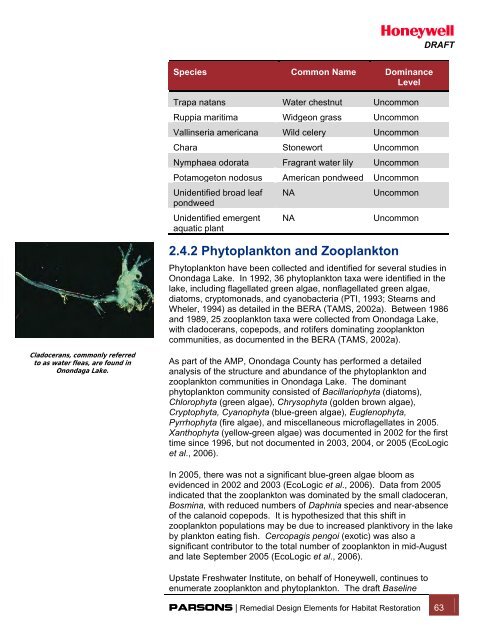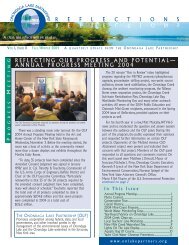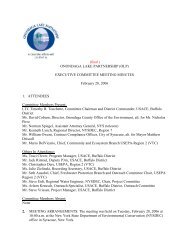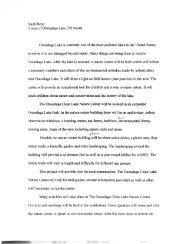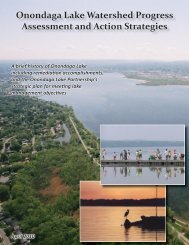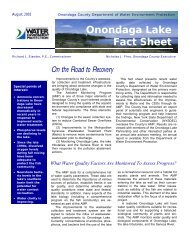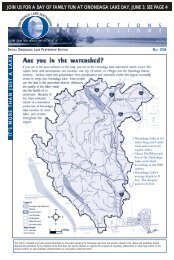Habitat Plan 2 - Onondaga Lake Partnership
Habitat Plan 2 - Onondaga Lake Partnership
Habitat Plan 2 - Onondaga Lake Partnership
You also want an ePaper? Increase the reach of your titles
YUMPU automatically turns print PDFs into web optimized ePapers that Google loves.
DRAFTSpecies Common Name DominanceLevelTrapa natans Water chestnut UncommonRuppia maritima Widgeon grass UncommonVallinseria americana Wild celery UncommonChara Stonewort UncommonNymphaea odorata Fragrant water lily UncommonPotamogeton nodosus American pondweed UncommonUnidentified broad leafpondweedUnidentified emergentaquatic plantNANAUncommonUncommon2.4.2 Phytoplankton and ZooplanktonPhytoplankton have been collected and identified for several studies in<strong>Onondaga</strong> <strong>Lake</strong>. In 1992, 36 phytoplankton taxa were identified in thelake, including flagellated green algae, nonflagellated green algae,diatoms, cryptomonads, and cyanobacteria (PTI, 1993; Stearns andWheler, 1994) as detailed in the BERA (TAMS, 2002a). Between 1986and 1989, 25 zooplankton taxa were collected from <strong>Onondaga</strong> <strong>Lake</strong>,with cladocerans, copepods, and rotifers dominating zooplanktoncommunities, as documented in the BERA (TAMS, 2002a).Cladocerans, commonly referredto as water fleas, are found in<strong>Onondaga</strong> <strong>Lake</strong>.As part of the AMP, <strong>Onondaga</strong> County has performed a detailedanalysis of the structure and abundance of the phytoplankton andzooplankton communities in <strong>Onondaga</strong> <strong>Lake</strong>. The dominantphytoplankton community consisted of Bacillariophyta (diatoms),Chlorophyta (green algae), Chrysophyta (golden brown algae),Cryptophyta, Cyanophyta (blue-green algae), Euglenophyta,Pyrrhophyta (fire algae), and miscellaneous microflagellates in 2005.Xanthophyta (yellow-green algae) was documented in 2002 for the firsttime since 1996, but not documented in 2003, 2004, or 2005 (EcoLogicet al., 2006).In 2005, there was not a significant blue-green algae bloom asevidenced in 2002 and 2003 (EcoLogic et al., 2006). Data from 2005indicated that the zooplankton was dominated by the small cladoceran,Bosmina, with reduced numbers of Daphnia species and near-absenceof the calanoid copepods. It is hypothesized that this shift inzooplankton populations may be due to increased planktivory in the lakeby plankton eating fish. Cercopagis pengoi (exotic) was also asignificant contributor to the total number of zooplankton in mid-Augustand late September 2005 (EcoLogic et al., 2006).Upstate Freshwater Institute, on behalf of Honeywell, continues toenumerate zooplankton and phytoplankton. The draft BaselinePARSONS | Remedial Design Elements for <strong>Habitat</strong> Restoration 63


